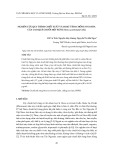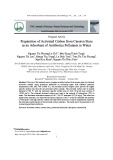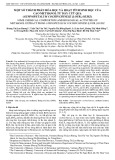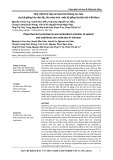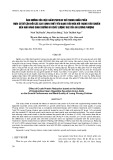
56 Nong Lam University, Ho Chi Minh City
The Journal of Agriculture and Development 23(Special issue 1) www.jad.hcmuaf.edu.vn
Dietary Saccharomyces cerevisiae supplementation improves feed intake and milk quality of
dairy cows
Hai T. Nguyen1, Loi V. Le1,2, Anh N. T. Dang1, & Cuong K. Nguyen2*
1Department of Animal Production, Nong Lam University, Ho Chi Minh City, Vietnam
2Department of Veterinary Biosciences, Nong Lam University, Ho Chi Minh City, Vietnam
ARTICLE INFO ABSTRACT
Research Paper
Received: August 16, 2024
Revised: October 01, 2024
Accepted: October 03, 2024
Keywords
Dairy cows
Feed consumption
Milk yield and quality
Saccharomyces cerevisiae
*Corresponding author
Nguyen Kien Cuong
Email:
cuong.nguyenkien@hcmuaf.edu.vn
The objective of this study was to evaluate the effects of daily
dietary supplementation of Saccharomyces cerevisiae-contained
product (SCP) on feed consumption, milk yield and quality of
milking cows under Vietnam weather condition from November
2022 to January 2023 at the dairy farm of ANOVA Binh Duong.
The study was conducted using a total of 94 Holstein Friesian (HF)
crossbred cows with at least 3/4 HF blood, with days in milk (DIM)
at days, and lasted 30 days (the first 15 days for the control without
SCP supplementation (control) and the next 15 days for the SCP
treatment with SCP addition at 5 g/cow per day (SCP). Results
showed that the average feed intake (as fed) of cows in the control
period was significantly lower than that of cows in the SCP period
(P < 0.01). The SCP supplementation did not affect (P > 0.05) the
milk productivity and milk fat, while milk protein, lactose, and
solids not fat (SNF) from the milk of cows in the SCP group were
significantly improved (P < 0.01). The SCP supplementation also
significantly enhanced (P < 0.05) the body condition score (BCS)
of dairy cows. Briefly, these results suggest that the dietary SCP
addition of 5 g/cow per day seems to significantly improve the feed
intake, BCS and milk quality parameters of lactating cows.
Cited as: Nguyen, H. T., Le, L. V., Dang, A. N. T., & Nguyen, C. K. (2024). Dietary Saccharomyces
cerevisiae supplementation improves feed intake and milk quality of dairy cows. The Journal of
Agriculture and Development 23 (Special issue 1), 56-62.

Nong Lam University, Ho Chi Minh City 57
The Journal of Agriculture and Development 23(Special issue 1) www.jad.hcmuaf.edu.vn
as a probiotic, which can positively influence the
gut health and metabolic processes of dairy cows.
It has been shown to improve feed efficiency,
increase milk yield, and improve milk quality by
modulating rumen fermentation and promoting
beneficial microbes (Chaucheyras-Durand et
al., 2008; Desnoyers et al., 2009). In Vietnam,
however, the practical benefits of a Saccharomyces
cerevisiae-contained product in dairy production
at local climate conditions are still limited and
this study is needed to clarify this point.
Therefore, the objective of the current study
was to determine the effects of one product that
contained the Saccharomyces cerevisiae on feed
consumption, milk yield, and quality of lactating
cows under Vietnam weather conditions.
2. Materials and Methods
2.1. Location
The study was conducted at the dairy farm of
ANOVA Binh Duong from November 2022 to
January 2023.
2.2. Experimental design, animals, and housing
The study was arranged into a randomized
complete design with two treatments of rations,
including (1) control with cows fed the current
farm-based ration and (2) Saccharomyces
cerevisiae-contained product (SCP) with cows
fed the control-like diet supplemented at 5 g/cow
per day of a Saccharomyces cerevisiae-contained
product (Biotic-Cattle at 1010 Saccharomyces
cerevisiae per g of product, SCP) (Table 1). Based
on the practical conditions of the farm, the study
was designed as one-group trial of cows before
(control) and after (SCP treatment) the SCP
addition into the daily diets of lactating cows.
Cows were housed in the same cubicle shed
1. Introduction
The dairy industry provides significant
nutritional and economic benefits to humans
and society, contributing significantly to the
development of global agriculture. In developing
countries, dairy production systems are affected
by many factors including genetics, nutrition,
infectious, parasitic diseases, or heat stress caused
by high temperature and humidity (Das et al.,
2016; Gauly & Ammer, 2020; Nguyen et al., 2021).
Dairy production in Vietnam has experienced
significant growth and development over the
past decade. Currently, the milk consumption in
Vietnam is still low at 27 liters/head per year (35
liters/head per year and 45 liters/head per year
in Thailand and Singapore in 2021, respectively)
and there will be a strong increase in demand for
humans in milk consumption to reach about 40
liters/head per year by 2030 (equivalent to the
growth rate of about 4% annually) (Nhat, 2023).
The development of the dairy system in Vietnam
requires the enhancement of knowledge and
skills of farmers related to the general husbandry
including genetics, nutrition, and heat stress
management (Nguyen et al., 2022). Nutritional
factors signigicantly affect milk yield and
compositions in addition to breed selection as a
primary step to improve milk productivity and
feed efficiency (Hristov et al., 2004; Lee et al.,
2014; Olika, 2021). Therefore, nutrient balance
in daily diets plays a significant role in dairy
production.
In recent years, there has been a lot of interest
in using products containing yeast, Saccharomyces
cerevisiae, as potential supplements (Majdoub-
Mathlouthi et al., 2009; Julien et al., 2018; Oh et
al., 2019). In fact, it is shown that there are widely
used these products in diets for high-yielding
dairy cows. Saccharomyces cerevisiae is known

58 Nong Lam University, Ho Chi Minh City
The Journal of Agriculture and Development 23(Special issue 1) www.jad.hcmuaf.edu.vn
lasted 30 days (the first 15 days for the control
treatment without SCP supplementation and
the next 15 days for the SCP treatment with SCP
addition) (Table 1).
Table 1. Experimental design
containing rubber mats with continual access to
water (ad libitum). The study was conducted on a
total of 94 Holstein Friesian (HF) crossbred cows
with at least 3/4 HF blood, with days in milk
(DIM) from 31 to 128 days (73.5 ± 25.9 days) and
Treatment Control
(No dietary SCP addition)
SCP
(Dietary SCP addition)
Cows (n) 94 94
Trial period The first 15 days The next 15 days
Daily SCP addition (g/cow per day) 0 5
SCP: Saccharomyces cerevisiae-contained product.
2.3. Daily ration of cows
All cows were fed twice a day (7:30 and 14:00,
ad libitum) as total mixed ration method (TMR)
as the current farm-based ration, including king
grass (28 kg/cow per day), alfalfa hay (2 kg/cow
per day), rice straw (0.5 kg/cow per day), corn
silage (4 kg/cow per day) complete feed (6 kg/cow
per day), molasses (0.5 kg/cow per day), brewers
grain (4 kg/cow per day), and other feed additives.
The Saccharomyces cerevisiae-contained product
(SCP) was mixed with new corn powder and
mixed well with TMR for the SCP treatment after
the trial period of the control. The TMR feed was
available at all positions of the feeding trough for
the same consumption per cow.
2.4. Sample collection and measurements
Milk yield (kg/cow per day): All cows were
milked by milking system into specialized
container two times a day (5:30 and 15:00), using
the recording machine in the milking system, and
then merging two times into the average milk yield.
Milk quality: About 50 mL of milk was taken
in the morning milking time to determine
concentrations of milk fat, protein, solids not
fat (SNF) and lactose, stored between 2 - 6°C
condition and transported quickly to an analytical
laboratory. Milk quality was analyzed by Ekomilk
M machine (BULTEH 2000, Bulgaria) about 60
sec/sample for the testing result. Before putting the
sample into the machine for analysis, the sample
must be shaken well and pour about 10 mL of milk
sample into the cup then press OK and wait for the
machine to measure for 90 sec.
Feed intake as fed (kg/cow per day): The total
amount of feed for each treatment was recorded
before feeding and refusal feed was collected
in the early morning for calculation of the feed
consumption as fed per day.
Temperature-humidity index (THI): Use a
specialized barn microclimate meter to measure
temperature and humidity at a height of 1.5m from
the house floor. Then, apply the equation to calculate
the THI = T (°F) - 0,55 * (100 - RH%)/100 * (T - 58)
(Ingraham et al., 1974; Nguyen et al., 2018).
Body condition score (BCS): Individual
cow was evaluated for BCS ranging from 1 to 5
according to the official method described by
Wildman et al. (1982) and Nguyen et al. (2022) on
the days of 15 and 30 of the experimental periods.

Nong Lam University, Ho Chi Minh City 59
The Journal of Agriculture and Development 23(Special issue 1) www.jad.hcmuaf.edu.vn
3.2. Milk yield and quality
The average milk yield of the control was
31.72 kg/cow per day and not different from that
of the SCP of 31.21 kg/cow per day (P > 0.05;
Figure 1). The results in the current study showed
that SCP supplementation into the daily diets for
dairy cows did not affect the milk productivity,
which is suitable with the previous findings of no
difference in milk yield between cow groups with
and without supplementation of Saccharomyces
cerevisiae fermentation product (Olagaray et al.,
2019). It is possible that the addition level (5 g/cow
per day) in this study is not enough to improve
the milk yield and milk yield is greatly affected
by many potential factors besides nutrition, such
as housing, heat stress, disease, etc.
2.5. Statistical analysis
Data were analyzed a Paired t-test using the Minitab Software 16.2. The percentages were
compared with the χ2 test. The differences were considered significant at P < 0.05.
3. Results and Discussion
3.1. Feed intake
Table 2. Effect of dietary SCP supplementation on feed consumption
Parameters Replication Control SCP P
Average THI 15 days 81.5 ± 0.9 81.3 ± 1.6 > 0.05
Average feed intake (kg/cow per day as fed) 94 cows 36.2b ± 1.3 40.3a ± 1.5 < 0.01
abMeans in the same row without common letters are different at P < 0.01; SCP: Saccharomyces cerevisiae-con-
tained product; THI: Temperature-humidity index.
The average THI in control within trial
period of cows fed the current farm-based ration
without SCP addition was 81.5 and not different
from that of SCP within the trial period of cows
fed diet supplemented SCP product at 81.3
(P > 0.05; Table 2). However, the average feed
intake (as fed) of cows fed the current farm-
based ration was 36.2 kg/cow per day and was
significantly lower than that of cows fed diet
supplemented SCP product of 40.3 kg/cow per
day (P < 0.01). Chaucheyras-Durand et al. (2008)
reported that the yeast product, Saccharomyces
cerevisiae, contains some potential factors that
stimulate the growth of rumen microorganisms,
especially for lactate-utilizing species. A stable
and well-developed rumen microflora will help
cows increase their feed intake (Olagaray et al.,
2019). In the rumen, SCP stimulates cellulolytic
bacteria to break down complex fibers in the
cow’s diet, thus making improvements in fiber
digestion, feed consumption and metabolism
efficiency (Desnoyers et al., 2009).

60 Nong Lam University, Ho Chi Minh City
The Journal of Agriculture and Development 23(Special issue 1) www.jad.hcmuaf.edu.vn
beneficial microbes (Chaucheyras-Durand et
al., 2008; Desnoyers et al., 2009). Therefore, this
improvement in nutrient absorption often results
in better milk composition, especially higher levels
of milk protein and SNF, without increasing the
overall milk productivity (Desnoyers et al., 2009).
Meanwhile, Olagaray et al. (2019) mentioned that
milk fat content increased by about 13% in the
milk of cows supplemented with Saccharomyces
cerevisiae.
Table 3. Effect of dietary SCP supplementation on milk quality parameters (n = 94 cows)
Milk quality Control SCP P
Milk fat (%) 3.90 ± 0.57 3.68 ± 0.30 0.327
Milk protein (%) 3.02b ± 0.08 3.10a ± 0.04 < 0.01
Milk lactose (%) 4.39b ± 0.14 4.51a ± 0.07 < 0.01
SNF (%) 8.00b ± 0.24 8.23a ± 0.10 < 0.01
abMeans in the same row without common letters are different at P < 0.01; SCP: Saccharomyces cerevisi-
ae-contained product; SNF: solids not fat.
Figure 1. Effect of SCP addition on milk yield during experiment (n = 94 cows). SCP:
Saccharomyces cerevisiae-contained product.
The average milk protein, lactose and SNF from
the milk of cows in the SCP group (3.10, 4.51 and
8.23, respectively) were significantly higher than
those of cows in the control group (3.02, 4.39 and
8.00, respectively) (P < 0.01; Table 3), while there
was no significant difference in the average milk
fat between the two groups (P > 0.05). It has been
reported that Saccharomyces cerevisiae enhances
the efficiency of nutrient utilization in dairy
cows by stabilizing ruminal pH and promoting
Milk yield (kg/cow per day)




